Nearly two-thirds (65%) of people who work for an organisation with a wellness programme or strategy in place believe it’s improving their health and wellbeing.
But still, some businesses are suffering from employee burnout. And small businesses could be being hit the hardest. New research shows that 67% of small business employees experience work-related stress or anxiety – with nearly half (46%) of workers continuing to work when they feel unwell, 18% feel guilty for taking time away from their desk for lunch, and more than a quarter send and receive emails outside of work hours, meaning that employees of small businesses are getting very little downtime to rest and recuperate during and outside of the working day.
And yet despite these findings, 82% of SME leaders do not currently have a health and wellbeing strategy in place to support their employees’ wellbeing*. Could it be that small businesses don’t fully understand the risks of stress, anxiety and an ‘always on’ mentality for their employees and their business?
How to help your employees engage in wellness programmes:
- Lead by example
- Encourage team work and camaraderie
- Encourage development of personal goals
- Make it fun
Your business's most valuable asset

“Leaders who support and enable a wellbeing-focused workplace can enjoy a more productive and profitable business. It’s often been said that if you look after your people, they will look after your customers, which drives your bottom line. But it’s also important for business leaders to note that you can’t look after your employees – or your business – if you don’t look after yourself.
The benefits of wellness
Wellness programmes can reduce stress and anxiety, and help cultivate time away from screens, which in turn can help enhance sleep, productivity, increase workplace and job satisfaction, increase workplace community and lower healthcare costs and time off.
But what if you have the wellness programme in place, but have found your employees are reluctant to join in and reap the benefits? How can businesses persuade their employees to engage in the wellness programmes they create?
Join in yourself!
It’s important that you work from the top down, with senior staff taking the lead and reminding employees that the programmes exist, and openly sharing the benefits they feel. “Leading by example and embedding good wellbeing habits in the workplace is incredibly important” explains Earle. “In small businesses leaders are often more visible among their team and can create the positive environment that helps their people thrive”. It’s also important to show more junior or newer members of staff that it is OK to take time away from their desk or work to engage in wellness programmes, and that they won’t be penalised for it, but celebrated.
Cultivate camaraderie!

Assist in creation and measurement of personal goals.
As humans, we love to measure and track our progress – think how successful the Fitbit has been! If teamwork isn’t possible, suggest apps or measurement programmes you employees can use to help them stay motivated by measuring their progress. For example, if employees are engaging in the OYNB Alcohol-Free Challenge, or giving up chocolate or coffee at their desk, the Quitzilla app is a great measurement tool to use on their phone that shows how many days and what percentage of the year they have abstained, and provides daily motivational quotes.
Kick off with an adventure.
Kicking off your wellness programme with a day or afternoon out of office can throw employees in at the deep end, show you mean business and that you are dedicated to their wellbeing. This may be even more true for smaller companies; in a recent survey, just 15 per cent of employees working in small businesses said they believe their company provides a culture which supports their mental health. If you show you’re serious, then you’re more likely to have a serious response from your employees.
If you would like to find out more about how One Year No Beer could benefit your organisation, email us at [email protected].

An entrepreneur and former senior oil broker, Ruari gave up drinking after excessive consumption almost cost him his marriage, and worse, his life. Going alcohol-free improved his relationships, career and energy levels, leading to him founding OYNB to provide a support network for others.







